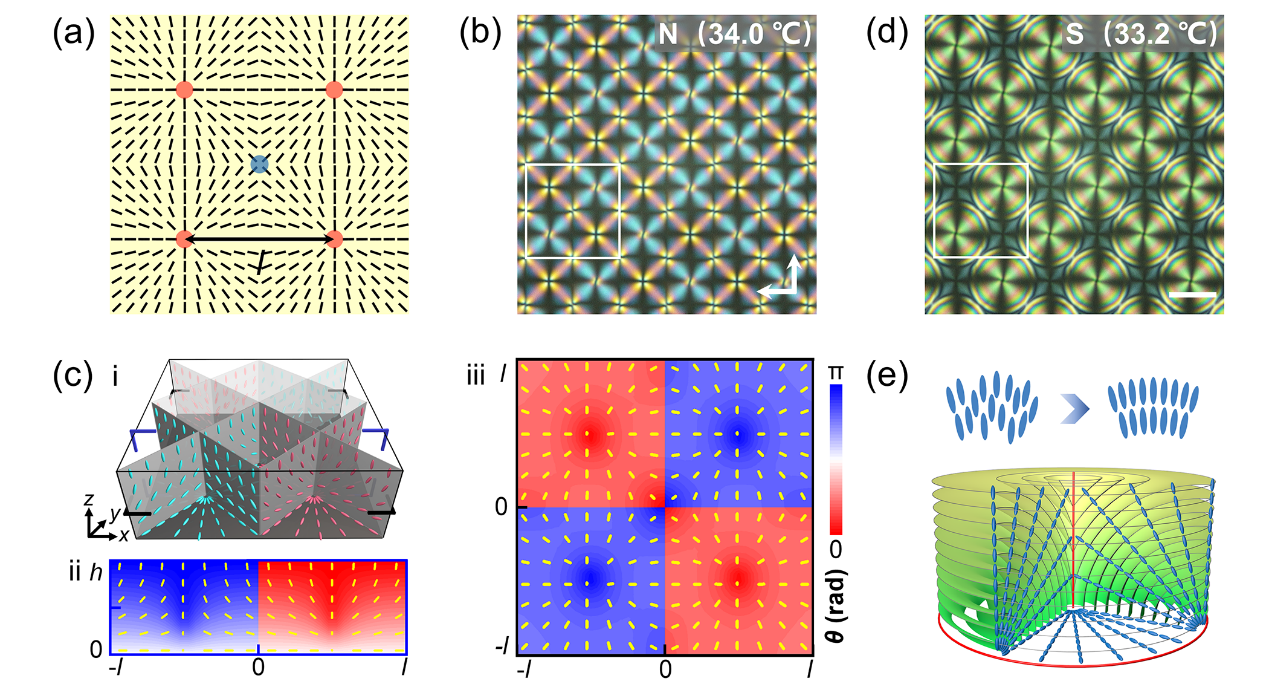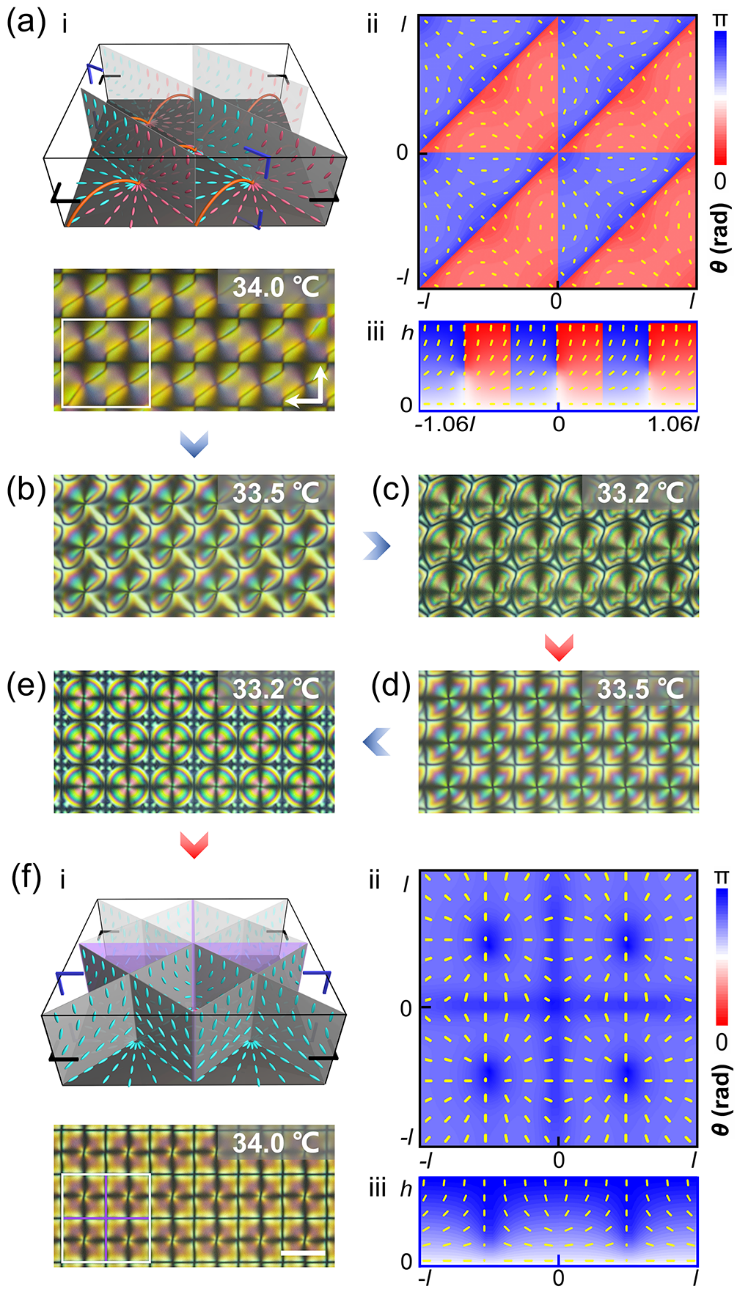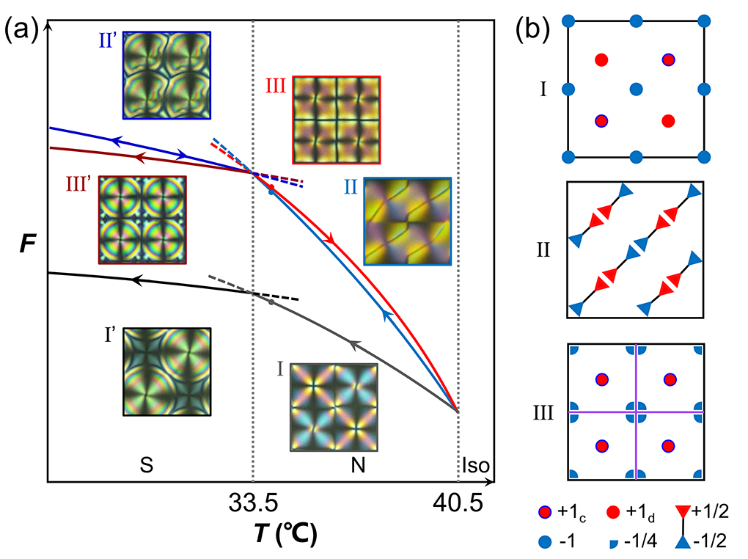Recently, a research team led by Professor Wei Hu and Professor Yan-Qing Lu at College of Engineering and Applied Science, Nanjing University, made significant progress in the order evolution of liquid crystal (LC) guided by topological defects across the nematic (N)-smectic (S) phase transition. The work has been published in PhysicalReviewLetters entitled “Topological Defect Guided Order Evolution across the Nematic-Smectic Phase Transition”. Phys. Rev. Lett. 130, 078101. (2023)
Topology, an unchanged property during continuous deformations in geometry or space, plays a key role in the frontier of condensed matter physics, including the quantum Hall effect, topological insulator and topological superconductor. The topological invariance endows corresponding systems with a protected symmetry that is rigorously defined by their topological characteristics. Symmetry breaking usually occurs during the phase transition of ordered systems, accompanied by the changes in topological defects. To date, the roles of topological defects in order evolution across phase transitions (such as Kosterlitz-Thouless phase transitions, 2D melting and cosmology in the laboratory) have always been an important topic of study.
LCs are ideal model systems because of their rich phases and topological defects, and are easy to realize a direct optical observation. In N phase, the rodlike LC molecules spontaneously orient along a dominant direction, referred to as the director. In equilibrium, the discontinuity of orientation will lead to the emergence of point defects, disclination lines and wall defects. Across the N-S phase transition, the LC molecules arrange in parallel to form separate layers, and have both orientational order and positional order. As a result, dislocations arise instead of the above defect species existing in the N phase. Although many researchers have studied the N-S phase transition, the role of topological defects in the evolution of LC order and their transformation mechanism across phase transition have not been investigated.

FIG. 1. (a) Lattice for alignment singularities of s = +1 (red dots) and −1 (blue dot). (b) POM image of the N phase texture at 34.0 °C. (c)-i Three-dimensional (3D) director fields of the texture in (b), ii & iii reveal simulated director fields and calculated distributions of θ in marked sections. (d) POM image of the S phase texture at 33.2 °C. (e) Director field evolution across N-S phase transition, the layered configuration and director distribution corresponding to single TFCD in Fig. 1d.
In this work, the research team investigates the generations and transformations of topological defects and their guidance on the order evolution during the N-S phase transition. With a given preset photopatterned alignment, two different topological defects are achieved via cooling from the isotropic state: a pure point defects array is generated in the N phase during a gentle cooling process [Fig. 1], and unidirectional disclination lines arise in rapid cooling [Fig. 2]. Due to the memory effect in LC order evolution, after the N-S phase transition, a stable array of toric focal conic domains (TFCDs) with a lattice constant of and a frustrated one are generated in S phase, respectively. Under the effect of minimizing the system energy, the frustrated TFCDs transfers to a metastable TFCD array with a lattice constant of l, and further transform to a crossed walls when reheated to N phase due to the inheritance of orientational order. The crossed walls are topologically protected and thus remains stable until transferring to the isotropic phase. The Landau-de Gennes numerical modeling is utilized to reproduce the director distributions of these three distinct N states and clarify their transformation mechanism.

FIG. 2. (a)-i 3D illustration and POM image of disclination lines (orange) in the N phase, ii & iii simulated director fields and calculated θ-distributions of the marked sections. (b-e) Textural evolution in thermal cycling. (f)-i 3D illustration and POM image of crossed walls (purple) in the N phase, ii & iii simulated director fields and calculated θ-distributions of the marked sections. Blue and red arrows represent cooling and heating processes, respectively. The corresponding temperatures are labeled in the upper-right corners.
In order to clearly show the above defect transformations across the N-S phase transition, the research team presents an energy-temperature diagram combining the experimental results and theoretical calculations [Fig. 3]. The energy relations of the three N textures are as follows: I (point defects) < II (disclination lines) < III (crossed walls); for the three S states: I’ (-TFCDs) < II’ (l-TFCDs) < III’ (frustrated TFCDs). The topological analysis shows that the total topological charge within a single unit is conserved during the N-S phase transition, while the specific types and distributions of topological defects are significantly different. The topological invariance limits the direct transformation between the three different N states.

FIG. 3. (a) Dependencies of F on T for different states across TN-S. (b) Topological analysis of the three different N states in (a).
This work reveals the transformation mechanism of topological defects across the N-S phase transition through combining the frustration evolution driven by the system free energy difference and the orientational order inheritance brought by the topological protection. It further shows the new metastable texture in LC. The emergence of novel phenomena may enrich the knowledge on self-organized ordered systems and pave the way for advanced applications of defects.
The co-first author of the paper are Dr. Sai-Bo Wu and PhD candidate Jin-Bing Wu, both from College of Engineering and Applied Science, Nanjing University. The corresponding authors are Professor Wei Hu and Professor Yan-Qing Lu. Hui-Min Cao also makes important contribution to this work. Professor Dong Miao and Professor Wei-Hua Zhang give constructive suggestions to this study. This work is supported by the National Natural Science Foundation of China (NSFC), Natural Science Foundation of Jiangsu Province and Fundamental Research Funds for the Central Universities.

